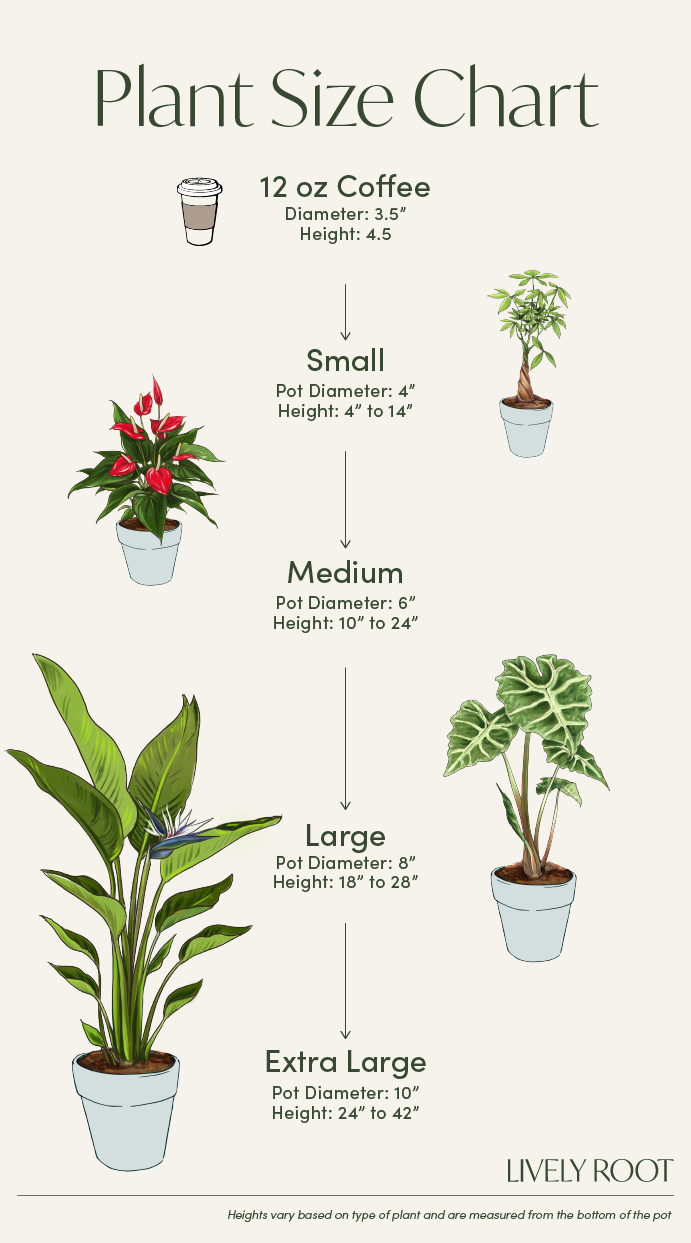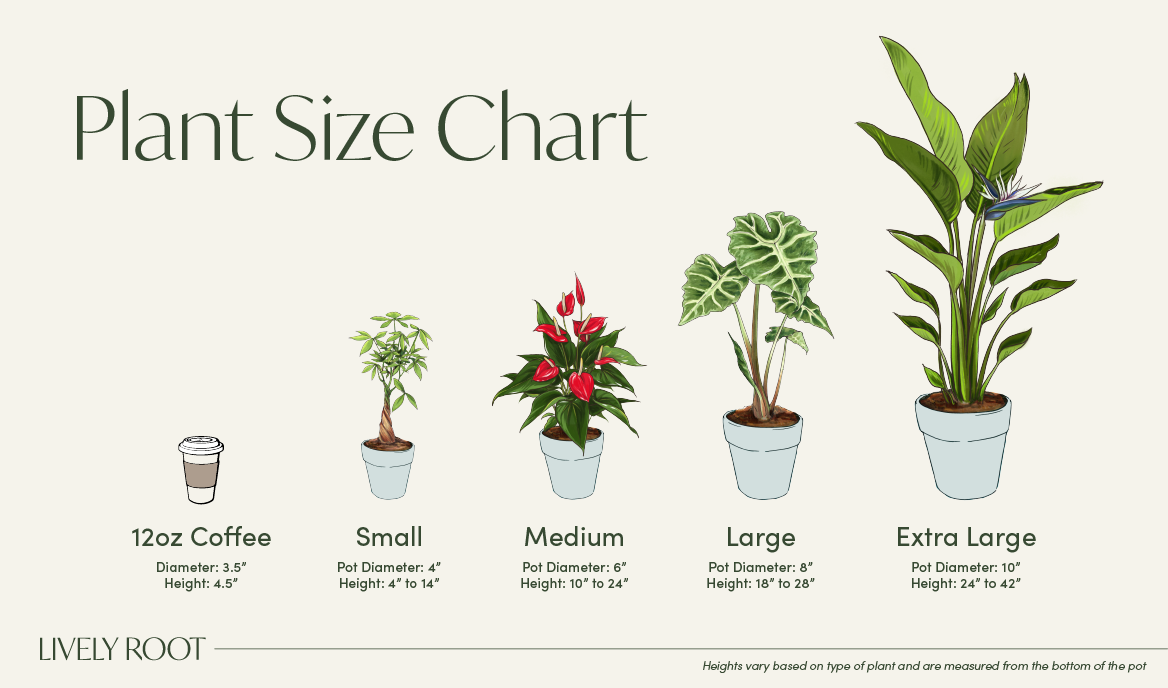

Add this cute Lemon Button Fern to your collection, a smaller version of the Boston fern. Only growing a foot high, it makes a beautiful ensemble with other tropicals. They have small and finely-textured leaves that are a nice contrast to larger leaf tropicals.
Lemon Button Fern Care Guide & Presentation

Enjoys medium to bright indirect sunlight indoors or in full shade, frost-free outdoor areas.
Keep consistently moist but can be forgiving if neglected at times.
These plants enjoy high levels of humidity indoors and outside.
Keep this plant on the warmer side and avoid cold drafts.
Outside: Keep them in full shade on a patio out of direct sunlight to prevent leaf burn where nights are above 55°F
Apply at half-strength a balanced, liquid fertilizer especially formulated for indoor plants every month.
When receiving the Lemon Button Fern, do not repot immediately but wait at least 6-12 months or if the roots are beginning to get crowded and growing through the drainage holes. They prefer to be a little crowded in their pot.
Repot in the spring, using a 2 inches bigger pot to give the roots room to spread.
Place a piece of screening at the bottom of the container over the drainage hole to secure the soil and allow to drain. Use a rich, well-draining indoor potting mix amended with 25% compost and to help with fertility.
Water your plant in the old pot before transferring over and let sit an hour.
Add well-draining potting soil amended with peat moss and perlite to the bottom to elevate the root ball. Lift the plant and release the roots against the existing planter. Use a clean knife or garden trowel to wedge between the pot and the soil to loosen.
Inspect the root ball. Notice if there are any dead or rotting roots and trim off with sterile pruners. If the plant is rootbound, cut through the roots to alleviate continued encircling.
Ensure the plant is sitting about 1 inch below the edge of the pot to avoid water spillage. Add more soil and backfill around the sides by tamping down. Fill up to the soil line but not over.
Water thoroughly, and unlike their cousins, they like to have a bit drier soil conditions. If settling occurs, add more soil.
Water well to dampen the soil and let drain.
When watering your fern, it is an excellent time to trim off any browning, yellowing, or discolored leaves. Cut the stem all the way back to the base. To revitalize them, cut all the old foliage down to the crown and avoid cutting off any rolled fiddleheads that are popping up. This will eventually produce new foliage for the year and keep your plant healthy.
Propagate and divide your Lemon Button Fern in the spring.
Hydrate the plant the night before.
Pull from the container and carefully divide or cut through the clump with a sterilized knife. Repot the fern in rich, indoor peat-based potting soil mix amended with a rooting hormone. Be aware that each new plant needs several leaves with sufficient roots attached.
Use a container 2 inches bigger than the root ball with drainage and deep enough for their roots to grow. Place the plant at the same level as the previous pot adding soil at the bottom.
Water the soil and add more soil if settling occurs.
Set them in medium to bright, indirect sunlight while they are rooting. Place a large, clear plastic bag, spritz with water on the interior and place over the new plant to create a humid environment. This particular fern does better with dryer soil conditions. Water weekly and keep on a consistent schedule.
Check the moisture and humidity each day and add misting to keep the humidity high while the roots establish.
After 6-8 weeks, roots will begin to establish. You can tug onto the stem to ensure the roots are anchoring well. Remove the plastic bag but keep the air humid around them with a pebble tray and misting.
Lemon Button Fern: Overview
The Lemon Button Fern (Nephrolepis cordifolia 'Duffii') is a charming dwarf variety of the Boston Fern. This versatile plant can grow both terrestrially and as an epiphyte. It features small, rounded leaflets that give off a faint lemony fragrance when brushed against. Typically reaching a height and spread of 12 to 18 inches, this compact fern is perfect for small spaces.
Belonging to the family Nephrolepidaceae, the Lemon Button Fern is native to tropical and subtropical regions, thriving in USDA hardiness zones 10-11. It prefers indirect sunlight, making it an ideal indoor plant that requires moderate care. Known for its resilience, the Lemon Fern can adapt to various environments, although it flourishes in humid conditions.
Ferns, in general, symbolize sincerity and magic in various cultures, and the Fern Lemon Button is no exception. Its delicate fronds and lush green appearance bring a touch of nature indoors, making it a popular choice for plant enthusiasts. Additionally, it is non-toxic and pet-friendly, ensuring a safe environment for households with pets.
For those looking to expand their fern collection, consider exploring fern varieties available at Lively Roots. For example, the Hurricane Fern (Asplenium antiquum 'Hurricane') and Kangaroo Fern (Microsorum diversifolium) are relatively rare varieties and boast unique aesthetics and similar care requirements.
Lemon Button Fern: Alternative Names
- Button Sword Fern
- Little-leaved Sword Fern
- Erect Sword Fern
- Fishbone Fern
- Dwarf Whitman Fern
Lemon Button Fern: Benefits
- Purifies the air, improving indoor air quality
- Adds aesthetic appeal with its lush, delicate fronds
- Easy-care plant, perfect for beginners
- Adds an exotic vibe to indoor and outdoor spaces
- Pet-friendly and non-toxic, safe for households with pets
Lemon Button Fern: Care Guide
The Button Fern is an easy-care plant that thrives in various indoor conditions, making it perfect for beginners. Below are detailed care instructions to ensure your fern stays healthy and vibrant.
Light and Temperature
The Lemon Button Fern prefers bright, indirect light but can tolerate lower light conditions. Avoid direct sunlight, which can scorch its delicate fronds. Ideal temperatures range from 60-70°F (16-22°C). Protect the plant from cold drafts and sudden temperature changes.
Watering and Humidity
Keep the soil consistently moist but not waterlogged. Water the plant when the top inch of soil feels dry. High humidity is essential for the fern's health. If your home is dry, increase humidity by misting the plant regularly or placing it on a humidity tray.
Soil and Repotting
Use a well-draining, peat-based potting mix. A mixture of peat moss, perlite, and pine bark works well. Repot the fern every 2-3 years or when it outgrows its current pot, preferably in the spring. Ensure the new pot has adequate drainage holes to prevent root rot.
Feeding and Pruning
Feed your Lemon Button Fern monthly during the growing season (spring and summer) with a balanced, water-soluble fertilizer diluted to half strength. Pruning is minimal; simply remove any dead or yellowing fronds to maintain its appearance and encourage new growth.
Propagation and Cleaning
Propagate the Lemon Button Fern through division. Divide the root ball into smaller sections, ensuring each section has healthy roots and fronds, then plant them in separate pots. Keep the plant clean by occasionally wiping the fronds with a damp cloth to remove dust and enhance its appearance.
Common Issues
Watch out for common issues, such as overwatering, which can lead to root rot, and insufficient light, which may cause yellowing fronds. Pests, like spider mites and scale, can occasionally affect the plant; treat infestations with insecticidal soap or neem oil. Ensure the plant receives adequate humidity to prevent brown leaf tips.
Fern Lemon Button: Placement, Companion & Alternative Plants
The Lemon Button Fern is a versatile tropical plant that enhances any indoor or outdoor space with its lush, green fronds and compact size. Here are some ideas for ideal placement and complementary plants to create a harmonious environment.
Best Locations & Uses
- Perfect for locations with bright, indirect light like living rooms and bathrooms.
- Ideal for hanging baskets or as an accent on shelves and tables.
- Suitable for terrariums, due to its small size and humidity needs.
- A great choice for offices to improve air quality and aesthetics.
- Perfect for novice gardeners, due to its easy-care requirements.
Companion Plants
Pair your Lemon Button Fern with other complementary indoor plants to enhance its beauty. Here are some perfect companions that thrive together.
- Heart Leaf Fern (Hemionitis arifolia): The Heart Leaf Fern pairs well with the Lemon Button Fern, creating a lush, green environment.
- Spider Plant (Chlorophytum comosum): With its arching leaves and easy-care nature, the Spider Plant complements the Lemon Button Fern's compact form.
- Golden Pothos (Epipremnum aureum): The Golden Pothos is a trailing plant with variegated leaves that enhance the visual appeal when placed alongside the Lemon Button Fern.
Alternative Plants
If you're looking for similar plants with comparable care needs and aesthetic appeal, consider these excellent alternatives, available at Lively Root.
- Maidenhair Fern (Adiantum raddianum): Similar in care needs and appearance, the Maidenhair fern is delicate and a great alternative for those who love ferns.
- Black Rabbit Foot Fern (Davallia fejeensis): Another pet-friendly option, the Black Rabbit Foor Fern provides a feathery texture that complements the Lemon Button Fern.
- Japanese Bird's Nest Fern (Asplenium antiquum): With its broad, wavy fronds, the Japanese Bird's Nest Fern adds a tropical feel and is equally easy to care for.
Order the Cute Lemon Button Fern From Lively Root Now
Add a touch of greenery to your home with the Lemon Button Fern. Buy yours from Lively Root today and enjoy the benefits of this charming and easy-care plant.
































